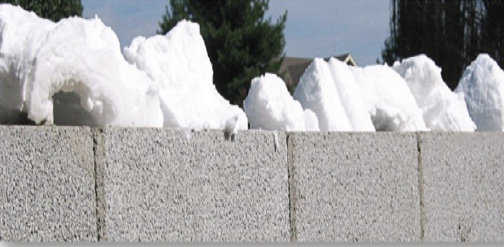Two of today’s major focus areas in the design community are reducing the amount of energy (usually in the form of fossil fuel to heat, cool and operate buildings) and reducing the embodied carbon in building materials. To help meet the moment, the concrete products industry has two readily available and affordable solutions that can be used to address both priorities:
1. Lightweight concrete masonry units (CMU), when made with lightweight aggregate like expanded shale, clay or slate, is the concrete world’s high-efficiency, energy-saving deliverable. Some will even say it qualifies as the concrete world’s version of insulation.
2. Dry-cast CMU are excellent at sequestering carbon dioxide (CO2). They readily absorb and convert atmospheric CO2 into limestone.

HIGH-EFFICIENCY LIGHTWEIGHT CMU
For many years, using insulation in ever-increasing quantities was the key to achieving energy efficiency in buildings. In today’s energy efficiency world, the name of the game, as far as buildings go, is “high efficiency.” Many believe that more energy savings are only to be found by using automated, high-efficiency lighting systems, hot water heaters, furnaces, air-conditioners and heat pumps. And while insulation specifications in walls, ceilings and floors still get a lot of attention, the Law of Diminishing Returns indicates that very little extra energy savings are found when adding more insulation.
A reliable solution—the concrete in a lightweight CMU—has roughly three times more resistance to heat flow than the regular concrete in a “normalweight” CMU. When combined with today’s “Next Generation” CMU (with thinner and fewer webs) insulated with injection foam, which completely fills all the hollow cores in a CMU wall and the tiny nooks and crannies between units, the net effect is a wall assembly with two to three times higher R-values than possible if the CMU were made with regular, normalweight concrete. (See Table 1)
When the entire lifespan of a building is considered, lightweight CMUs’ higher R-value saves significant amounts of heating and cooling energy. So much energy is saved that even though a normalweight CMU’s environmental product declaration (EPD) is better than a lightweight CMU’s EPD, the cumulative energy saved with insulated lightweight CMU, thanks to its higher R-value, creates a net positive impact for a building.

CMU SEQUESTER CARBON
Receiving equal attention, if not more, is the design community’s goal of reducing the amount of a) embodied carbon contained in building materials, and b) energy required to operate buildings built with today’s materials. The Concrete Masonry & Hardscapes Association (CMHA) is studying how much CO2 typical CMU can sequester. Results so far are very encouraging. Due to the thinness of CMU face shells and cross webs and the more porous structure of the dry-cast concrete, atmospheric CO2 can easily penetrate the CMU matrix, differentiating it from wet-cast concrete. This results in significantly higher natural carbonation rates.
While the concrete industry continues advocating that today’s ‘cradle to gate’ EPDs do not fully capture a material’s impact on energy savings or on its larger carbon footprint, it is important for the design community to know that these two solutions offered by the concrete industry are readily available and inexpensive to implement. As Chair of American Concrete Institute/The Masonry Society Joint Committee 122 on Energy Efficiency of Concrete and Masonry Systems and two other CMU-related committees, I have learned that these are two of the few timely solutions that our industry offers. Another very important one is to use the “trade-off” compliance path and accompanying COMCheck software program to meet energy code requirements. However, we need more solutions. For which, we need to come together as an industry and support creating and sharing these solutions with our design community partners. If you are interested in becoming an ACI/TMS 122 member or discussing more about these or other solutions, please contact me directly.

Along with the ACI/TMS Joint Committee 122, Kevin Cavanaugh chairs the Concrete Masonry & Hardscapes Association CMU Technical Committee and Expanded Shale, Clay and Slate Institute Masonry Committee. He has worked for large, multi-national and small, family-owned concrete masonry unit and several lightweight aggregate producers. He enjoys the people in the concrete and masonry industries and educating owners, architects, mason contractors and masonry suppliers on lightweight CMUs’ many benefits. He can be reached at [email protected] or 414/559-6434.